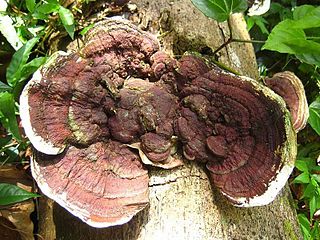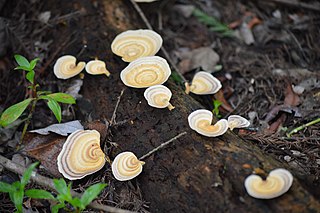Related Research Articles

Junghuhnia is a genus of crust fungi in the family Steccherinaceae. It was circumscribed by Czech mycologist August Carl Joseph Corda in 1842. The generic name honours German-Dutch botanist Franz Wilhelm Junghuhn.

The Polyporaceae are a family of poroid fungi belonging to the Basidiomycota. The flesh of their fruit bodies varies from soft to very tough. Most members of this family have their hymenium in vertical pores on the underside of the caps, but some of them have gills or gill-like structures. Many species are brackets, but others have a definite stipe – for example, Polyporus badius.

Rigidoporus is a genus of fungi in the family Meripilaceae. Many of the species in this genus are plant pathogens. The widespread genus, which contains about forty species, was originally circumscribed by American mycologist William Alphonso Murrill in 1905. The generic name combines the Latin word rigidus ("rigid") with the Ancient Greek word πόρος ("pore").

Ceriporia is a widely distributed genus of crust fungi.

Amauroderma is a genus of polypore fungi in the family Ganodermataceae. The genus, widespread in tropical areas, contains about 70 species. Amauroderma fungi are wood-decay fungi that feed and fruit on decayed branches and trunks.

Aurantiporus is a genus of poroid fungi in the family Meruliaceae. Circumscribed by American mycologist William Alphonso Murrill in 1905, the genus contains five species found mostly in northern temperate regions. Molecular analysis of several Aurantiporus species suggests that the genus is not monophyletic, but some other related polypore species need to be sequenced and studied before appropriate taxonomic changes can be made. In 2018, Viktor Papp and Bálint Dima proposed a new genus Odoria to contain Aurantiporus alborubescens based on multigene phylogenetic analyses. The generic name is derived from the Latin aurantius ("orange") and the Ancient Greek πόρος (pore).

Diplomitoporus is a genus of fungi in the family Polyporaceae. The Dictionary of the Fungi estimated the widespread genus to contain 11 species; since then, the genus has grown with the additional of several newly described species, and some transfers from other genera. Diplomitoporus has been described as a wastebasket taxon, containing "species that share common macroscopic and microscopic characteristics, but are not necessarily related."

Earliella is a fungal genus in the family Polyporaceae. It is a monotypic genus, containing the single species Earliella scabrosa. It is found in Hainan.

Fuscocerrena is a fungal genus in the family Polyporaceae. It is a monotypic genus, containing the single polypore species Fuscocerrena portoricensis, found in eastern North America, Central America, and South America.

Microporellus is a genus of poroid fungi in the family Polyporaceae.

Skeletocutis is a genus of about 40 species of poroid fungi in the family Polyporaceae. The genus has a cosmopolitan distribution, although most species are found in the Northern Hemisphere. It causes a white rot in a diverse array of woody substrates, and the fruit bodies grow as a crust on the surface of the decaying wood. Sometimes the edges of the crust are turned outward to form rudimentary bracket-like caps.

Tyromyces is a genus of poroid fungi in the family Polyporaceae. It was circumscribed by mycologist Petter Karsten in 1881. The type species is the widely distributed Tyromyces chioneus, commonly known as the white cheese polypore. The phylogenetic position of Tyromyces within the Polyporales is uncertain, but it appears that it does not belong to the "core polyporoid clade". Tyromyces is polyphyletic as it is currently circumscribed, and has been described as "a dumping place for monomitic white-rot species with thin-walled spores."
Skeletocutis bicolor is a species of poroid crust fungus in the family Polyporaceae. It is found in Singapore.
Skeletocutis brevispora is a species of poroid crust fungus in the family Polyporaceae. It was described as new to science in 1998 by Finnish mycologist Tuomo Niemelä.
Skeletocutis brunneomarginata is a species of poroid crust fungus in the family Polyporaceae. Found in the United States, it was described as new to science in 2007 by Norwegian mycologist Leif Ryvarden. He collected the type in Bent Creek Experimental Forest, North Carolina in 2004. The fungus is very similar in appearance to Skeletocutis kühneri, but with a brown margin and subiculum. S. brunneomarginata is one of 14 Skeletocutis species that occurs in North America.

Nigroporus vinosus is a species of poroid fungus in the family Steccherinaceae, and the type species of the genus Nigroporus. Its fruit bodies have brownish caps with tinges of purple or red. The cap underside has a pore surface the same colour as the cap, and minute pores. Nigroporus vinosus has a pantropical distribution. It has been recorded from Africa, North America, Central America, South America, Asia, and Oceania. It is a wood-decay fungus that causes a white rot.
Skeletocutis microcarpa is a species of poroid fungus in the family Polyporaceae that is found in Venezuela. It was reported as a new species by mycologists Leif Ryvarden and Teresa Iturriaga. The type collection was made in January 1997, in Yutajé, where it was found growing on the bark of a living tree. The fruit bodies of this fungus are in the form of small brown caps measuring up to 8 mm wide and long by 4 mm thick. Its spores are smooth, ellipsoid, hyaline, and measure 3–3.3 by 2 μm.
Skeletocutis subodora is a species of poroid crust fungus in the family Polyporaceae. It was described as a new species by mycologists Josef Vlasák and Leif Ryvarden in 2012. The type specimen was collected in the Crater Lake visitor's centre in Oregon, United States, where it was growing on a log of Douglas fir. It is named after its similarity to Skeletocutis odora, from which it differs in microscopic characteristics, including its thick subiculum, non-allantoid (sausage-shaped) spores, large cystidioles, and monomitic flesh.

Loweomyces fractipes is a species of poroid fungus in the family Steccherinaceae, and the type species of the genus Loweomyces. It is a widely distributed species, found in North America, Europe, Central America, South America, and Korea.
References
- ↑ "GSD Species Synonymy:Skeletocutis niveicolor (Murrill) Ryvarden". Species Fungorum. Kew Mycology. Retrieved 2018-04-08.
- ↑ Murrill, W.A. (1920). "Light-colored resupinate polypores. I". Mycologia. 12 (2): 77–92. doi:10.1080/00275514.1920.12016821.
- ↑ Ryvarden, Leif (1985). "Type studies in the Polyporaceae 17. Species described by W.A. Murrill". Mycotaxon. 23: 169–198.
- ↑ Wright, Jorge E.; Wright, Alicia M. (2005). "Checklist of the Mycobiota of Iguazú National Park (Misiones, Argentina)". Boletín de la Sociedad Argentina de Botánica. 40 (1–2).

- ↑ Carranza Velázquez, Julieta; Ruiz-Boyer, Armando (2005). "Checklist of polypores of Costa Rica". Revista Mexicana de Micología. 20: 45–52.
